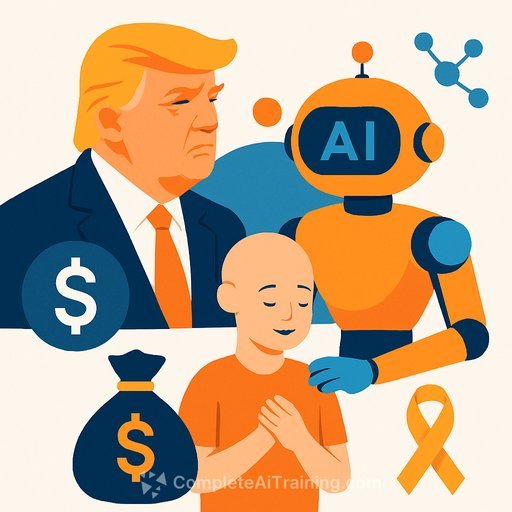Unlocking Cures: How AI Is Reshaping Cancer Research and Healthcare ETFs
AI is now embedded across U.S. healthcare-from diagnostics to care operations. Personalized treatment plans, faster reads, and automated workflows are moving from pilots to daily practice. North America accounted for about 44.7% of global AI-in-oncology revenue in 2024, signaling strong momentum for cancer R&D and the companies that power it.
Challenges remain: data quality, privacy, and clear guardrails for clinical use. Progress depends on better data governance and pragmatic regulation that supports patient safety without stalling innovation. For providers and health systems, the signal is clear: AI capability is becoming core infrastructure.
A Presidential Push for Pediatric Cancer and ETF Implications
On Sept. 30, 2025, President Donald Trump signed an executive order that doubled the NIH investment in the childhood cancer data initiative with an additional $50 million. The order prioritizes stronger data infrastructure, deeper analysis of complex biology, and smarter clinical trials-areas where AI can compress timelines and improve targeting.
This direction could favor companies already active in pediatric oncology and AI-driven diagnostics, including Johnson & Johnson, Merck, Eli Lilly, and Boston Scientific. Healthcare ETFs with meaningful exposure to these names-such as Vanguard Health Care ETF (VHT) and iShares Global Healthcare ETF (IXJ)-stand to benefit if execution and pipelines continue to deliver.
For context on the underlying program, see the NIH Childhood Cancer Data Initiative (CCDI). For clinicians and quality leaders tracking AI adoption in care, FDA resources on AI/ML-enabled medical devices are also useful (FDA AI/ML).
Healthcare ETFs in Focus
Multiple forces are lifting healthcare ETFs in 2025 compared with 2024: strong M&A, steady product launches in pharma and devices, demographic demand, and broader AI use across clinical and commercial functions.
Vanguard Health Care ETF (VHT)
- Focus: U.S. healthcare equipment, services, pharma, and biotech.
- Top holdings: Eli Lilly (10.16%), AbbVie (5.38%), Johnson & Johnson (5.07%). All are engaged in pediatric cancer research.
- Performance: Up 1% in 2024; up 2.3% year-to-date.
- Fee: 9 bps.
iShares Global Healthcare ETF (IXJ)
- Focus: Global pharma, biotech, and medical device companies.
- Top holdings: Eli Lilly (8.21%), Johnson & Johnson (6.21%), AbbVie (5.60%).
- Performance: Down 1.1% in 2024; up 3.1% year-to-date.
- Fee: 40 bps.
SPDR S&P Biotech ETF (XBI)
- Focus: Broad U.S. biotech exposure.
- Top holdings include Exelixis (1.97%) and United Therapeutics (1.96%), both active in pediatric cancer research and support.
- Performance: Up 0.7% in 2024; up 11.3% year-to-date.
- Fee: 35 bps.
What This Means for Healthcare Leaders
- Data readiness: Prioritize clean, labeled, interoperable datasets-especially for oncology. Good data shortens model validation cycles and improves clinical utility.
- Governance: Establish clear policies for AI oversight, audit trails, and bias monitoring. Align with IRB standards and device-level guidance where applicable.
- Clinical integration: Focus on workflow fit. Tools that save clinicians time (triage, imaging reads, notes) see faster adoption and better outcomes.
- Trials and registries: Use AI to improve trial design, site selection, and patient matching-key for pediatric indications with small populations.
- Vendor selection: Require transparent performance metrics, external validation, and security posture. Insist on ongoing monitoring, not one-time proof.
Next Steps
- Map AI use cases that tie directly to quality, access, and cost-of-care goals in oncology.
- Partner with oncology leaders to pilot decision support tools where data depth is strongest (imaging, pathology, genomics).
- Track policy updates and fund flows affecting pediatrics; align grants and collaborations to emerging standards.
If you're building AI fluency across clinical, research, or ops teams, explore practical upskilling resources: AI courses by job role and latest AI courses.
Note: This content is for informational purposes only and is not investment advice. Fund holdings, performance, and fees can change; review each fund's latest materials before making decisions.
Your membership also unlocks:






